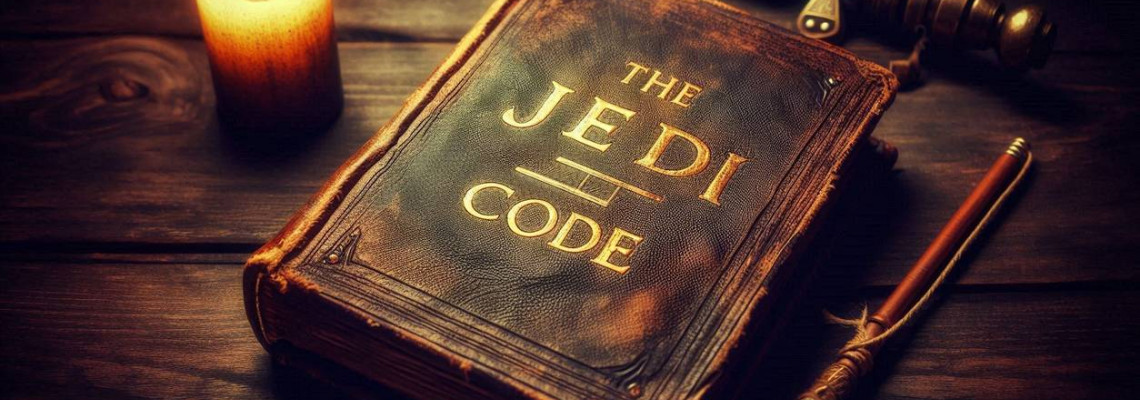
What Is the Jedi Code and How Does Its Mantra Guide Jedi?
1. What is the Jedi Code?
A set of tenets and beliefs known as the Jedi Code served as the Jedi Order's compass. This Code, which was applicable to all Jedi grades within the Order—initiates, Padawan's, Knights, and Masters—evolved over generations.
One of the Code's rules was that Jedi could not train more than one Padawan at a time. With its emphasis on self-control, reflection, and self-discipline, the Code also embodied the Order's fundamental philosophical principles. It was created to assist the Jedi in rejecting the temptations of the dark side of the Force and remaining dedicated to the light side.
The Great Jedi Purge nearly destroyed the Order during the Imperial Era, leaving only a handful of Jedi Code adherents. Jedi Master Luke Skywalker taught his disciples, including his nephew Ben Solo, to follow the Jedi Code when the Order was founded during the New Republic Era.
2. Origins and Evolution of the Jedi Code
Over millennia, the Order's determination to reject any path that might lead to the dark side of the Force and remain in alignment with the light side fueled the development of the Jedi Code. As the first person to utilize the Force under an early Jedi Code, the so-called "Prime Jedi," the creator and original member of the Jedi Order, was the first to do so by adhering to an early version of the Jedi Code.
Jedi Master Odan-Urr. Marda was thought to be the creator of the current version of the Code. After falling in love with the Padawan Kevmo Zink, Ro, a Path of the Open Hand member, thought she might convince him to reject the Jedi ways and join her in the Path. But in the end, the Great Leveler killed Zink, and Ro accused the Jedi of brainwashing him into believing false things.
While all Jedi were required to follow the Code, Jedi Master Qui-Gon Jinn was notorious for putting the will of the Force ahead of the Code's principles. His propensity to disobey the Jedi High Council caused him to clash with the Order's leadership and even his apprentice, Obi-Wan Kenobi, who believed that if Jinn had adhered to the Code more closely, he might have joined the Council.
Because the Code prohibited training more than one Padawan, the High Council turned down Jinn's offer to train Anakin Skywalker, who was thought to be the Chosen One, in the latter years of the Galactic Republic. Nevertheless, after the Sith apprentice Darth Maul killed Jinn during the Invasion of Naboo, the Council allowed Kenobi to train Skywalker.
It was difficult for Iskat Akaris, a Jedi Knight who excelled during the Clone Wars, to adhere to the Jedi Code, especially the phrase "there is no death, there is the Force." She thought the words of the Code were meaningless as she saw other Jedi. She once accidentally read parts of the Code backward when teaching younglings, stating, "There is no serenity; there is passion." This was a reflection of her internal strife, even though she said it was a test to see if the younglings would notice.
Republic officer Captain Wilhuff Tarkin said the Jedi Code inhibited the Order from taking the necessary actions to defeat the Confederacy of Independent Systems during the Clone Wars. While Jedi Commander Ahsoka Tano disagreed with Tarkin's position that the Jedi should give up command of the Grand Army of the Republic, Jedi General Obi-Wan Kenobi thought Tarkin's ideas were too basic.
Anakin Skywalker thought it was against the Jedi Code when Kenobi and other Jedi High Council members urged him to spy on Supreme Chancellor Sheev Palpatine just before the Clone Wars ended.
Luke Skywalker instructed his trainees in Jedi ways as part of his effort to bring the Order back to life. Because of his non-traditional training, he desired to provide his students with a more conventional Jedi experience. Skywalker upheld the Jedi Code as a Jedi, and he expected his followers—including his nephew Ben Solo—to do the same.
Skywalker dedicated his life to the Jedi path, avoiding romantic relationships, separating from old acquaintances, and making endless efforts to restore the Order. In spite of the Jedi Code's emphasis on upholding personal detachment, Skywalker felt some remorse for the time he was apart from his friends, even though his dedication to the Code made him feel fulfilled.
The tree library on Ahch-To contained the ancient Jedi manuscripts, and in 34 ABY, Rey heard the Jedi Code being softly spoken. The chanting drew her in, and she went into the library, where she found the scrolls and started learning more about Luke Skywalker's background with the Jedi Order.
3. What Are the Core Tenets of the Jedi Code?
The Jedi Code was a collection of values and guidelines that influenced the Jedi Order's behavior and convictions. Members of the Code avoided fear and the dark side of the Force by resisting feelings of hatred toward other living things.
According to the Jedi Code, a Jedi could only train one pupil at a time. Additionally, the Code forbade Jedi from seeking retribution or murdering helpless adversaries. The Jedi Code, among other rules, forbade Jedi Knights and Jedi Masters from training more than one Padawan at once.
Additionally, the Code prohibited attachment. Grand Master Yoda cautioned that attachment can breed greed, jealousy, and ultimately, a fear of losing something, all of which can lead to adverse outcomes. In a similar vein, Ahsoka Tano refused to train Grogu as an apprentice because of the youngling's association with Mandalorian bounty hunter Din Djarin, believing attachment to be harmful.
Even while attachment was prohibited, the Code emphasized compassion as a key component of the Jedi way of life, teaching that all lives were precious, a lesson that outsiders sometimes misinterpreted. The Code did not prohibit love, either romantic or familial, even if Jedi did not get married. The Jedi path, whose teachings rarely coincided with conventional familial ties, was said to be abandoned if one gave way to personal attachment.
4. What Does the Jedi Code's Mantra Teach?
Trained in the light side of the Force's precepts, a Jedi such as Obi-Wan Kenobi could find Serenity in the Jedi Code's motto:
Peace reigns, and there is no feeling.
There is knowledge, not ignorance.
Instead of emotion, there is calm.
Harmony exists instead of chaos.
Death does not exist; only the Force does.
Another version of the Code was also read by Depa Billaba when she retook her complete fitness evaluation following a six-month coma, as well as by Jedi younglings during their Initiate Trials:
Peace and emotion.
Not knowing, yet knowing.
Passion, but calm.
Anarchy, yet peace.
Death but the Force.
By 382 BBY, another older version of the Code had been established, emphasizing that the Jedi prioritized knowledge and enlightenment over self-serving ambitions for power or wealth. This earlier phrase was known by heart to Jedi Master Vildar Mac and Jedi Knight Oliviah Zeveron, but Padawan Matthea Cathley only knew it from historical accounts. Even though the previous motto was outdated, its principles still applied to Jedi behavior. This version contained:
"A Jedi acts solely in pursuit of knowledge and enlightenment, not for wealth or personal power."
5. How Did the Jedi Code Influence Jedi Actions?
By protecting against the dark side, dealing with love and attachment, striking a balance between relationships and obligations, controlling emotions to preserve composure, and influencing their outlook on death, the Jedi Code shaped Jedi behavior.
5.1 How Did the Jedi Code Guard Against the Dark Side?
Instead of letting the dark side rule them, Jedi were taught to embrace it and learn to harness it. It took time and training to remove the dark side's elements of fear of loss, rage, hatred, jealousy, greed, and violence from a Jedi.
5.2 How Did the Jedi Code Address Love and Attachment?
The Jedi were encouraged and taught to love in terms of compassion, even if the Jedi Code prohibited attachment and possession. A Jedi was "allowed to like people and things," but attachments could not rule their lives, according to Jedi Master Zallah Macri, who was describing the Code to her disciple Kevmo Zink. According to Jedi Knight Indeera Stokes, the light side included love as well as feelings of joy, affection, and sorrow, but a Jedi was immune to these feelings.
Attachment was the inability to accept death as usual, the unwillingness to let go, or the denial of acknowledging that change was a part of life. Jealousy, a selfish state that swings one toward the dark side, may result from this mindset, which stokes greed and the dread of losing something. Jedi were instructed to let go of anything they dreaded losing; therefore, attachment was forbidden.
Jedi might demonstrate love, care, and compassion in this way without becoming possessive or holding onto things; instead, they could embrace life's constant change. As a result, they were able to love all life without developing attachments to particular people.
Anakin Skywalker is a prime example of a Jedi whose attachments drove him to the dark side. His compulsive need to acquire the ability to save his wife from death drove him to turn to the Sith.
5.3 How Did the Jedi Balance Relationships with Their Responsibilities?
Jedi treated each other as if they were family, and occasionally, they were even blood relatives. Jedi Masters formed close relationships with their apprentices, providing them with the affection and confidence of a parent. They were supposed to put the lives of many before their own, avoid attachments, and be prepared to release their apprentices if needed for the greater good.
Romantic feelings were seen by the Jedi as "natural," not explicitly prohibited. But Jedi Master Obi-Wan Kenobi pointed her that romantic connections were not intended for Jedi. Even if it meant ending a personal connection, a Jedi Knight had to make the right decision for the Order and refrain from sacrificing their Jedi duties for a personal relationship.
As long as there were no attachments involved, Jedi Knight Rael Averross thought the Code permitted casual romances. During his tenure as Lord Regent on Pijal, Averross developed a close bond with Selbie, an innkeeper on the island. Qui-Gon Jinn, a Jedi friend of his, disagreed with Averross's reading of the Code.
5.4 How Did Jedi Manage Emotions to Maintain Serenity?
The Jedi were urged to trust their gut feelings rather than their intellect. They were taught to be conscious of their feelings, even if they were appreciated because unrestrained emotions could impair judgment. A Jedi had to keep their mind pure and peaceful to stay on the light side of the Force and away from the dark side. In this balanced state, they could maintain the Force within them steady.
5.5 What Was the Jedi Perspective on Death?
All life forms eventually died, and the Jedi understood that the cosmos was dynamic. The Force was critical to them, and they took solace in the fact that, like all living things, they would join with the Cosmic Force, the source of the Living Force, after they died. Because of this knowledge, they were able to accept death as a regular aspect of life.
They were reminded that, despite the pain that comes with death, they should not lament their loss but rather embrace their ultimate passage and honor the lives of those who joined the Force. The shadow of greed and attachment was the source of the fear of losing others to death.
6. What Are the Limitations and Criticisms of the Jedi Code?
The severe approach of the Jedi Code, especially in the areas of emotional repression and connection prohibitions, has drawn criticism despite its admirable goals. The Code's emphasis on emotional control frequently results in repression rather than actual mastery, which has caused issues for a number of Jedi, such as Anakin Skywalker, who found it challenging to balance his fear with affection for the people he loved. Jedi found it challenging to build positive interpersonal ties because of their aversion to attachment, which isolated them at times when they could have most needed help.
Even the eventual demise of the Order has been attributed to the rigor of the Jedi Code. The Jedi might not have been able to adjust to the galaxy's changes and the Sith's evolving danger because they were forced to follow a rigid set of rules. They were exposed because they were unable to anticipate Emperor Palpatine's ascent and the Republic's eventual fall due to their rigidity and resistance to different points of view.




















